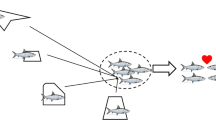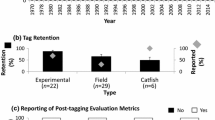Abstract
Identifying individuals by their natural body markings is an excellent surrogate for artificial tags. Photo identification has been primarily tested in oceanic species but has not been extensively used on freshwater fish. Brook trout are renowned for their lateral spot patterns. In this study, Interactive Individual Identification System was used to digitize and assess spot pattern uniqueness for identifying individual brook trout within a population for a short-term mark-recapture study. Brook trout were sampled over multiple days in Harper Creek and captured 315 specimens. Photo images were collected of their left lateral side and digitized. Based on photo identification, 263 unique brook trout were sampled. Additionally, there were 36 recaptures: 29 sampled twice, six sampled three times, and one sampled four times enabling a population estimate to be derived. In 2019, Harper Creek supported a spawning population of 514.4 (408–659; 95% CIs) brook trout. Ninety-four unique brook trout were sampled from a geographically distinct population of which none of the spot patterns matched the Harper Creek population. Spot patterns were distinct between lateral sides of an individual fish. Spot patterns on brook trout are unique and can be used to as a non-invasive means to identify individual at least in short-term projects.





Similar content being viewed by others
Data availability
Data is available from author upon reasonable request.
Code availability
Code for m/r is available from the author upon reasonable request.
References
Blair SG (2019) Seasonal habitat use and movement of native brook trout (Salvelinus fontanalis) in Urban Headwater Streams. Trent University
Bonner SJ, Holmberg J (2013) Mark-recapture with multiple, non-invasive marks. Biometrics 69:766–775. https://doi.org/10.1111/biom.12045
Castillo GC, Sandford ME, Hung TC et al (2018) Using natural marks to identify individual cultured adult delta smelt. North Am J Fish Manag 38:698–705. https://doi.org/10.1002/nafm.10066
Chaves LCT, Hall J, Feitosa JLL, Côté IM (2016) Photo-identification as a simple tool for studying invasive lionfish Pterois volitans populations. J Fish Biol 88:800–804. https://doi.org/10.1111/jfb.12857
Correia M, Palma J, Koldewey H, Andrade JP (2014) The use of a non-invasive tool for capture-recapture studies on a seahorse Hippocampus guttulatus population. J Fish Biol 84:872–884. https://doi.org/10.1111/jfb.12304
González-Ramos MS, Santos-Moreno A, Rosas-Alquicira EF, Fuentes-Mascorro G (2017) Validation of photo-identification as a mark–recapture method in the spotted eagle ray Aetobatus narinari. J Fish Biol 90:1021–1030. https://doi.org/10.1111/jfb.13215
Haxton T, Ball H, Armstrong K (2020) Expert opinion on the status and stressors of brook trout, Salvelinus fontinalis, in Ontario. Fish Manag Ecol 27:111–122. https://doi.org/10.1111/fme.12376
Hook SA, McMurray C, Ripley DM et al (2019) Recognition software successfully aids the identification of individual small-spotted catsharks Scyliorhinus canicula during their first year of life. J Fish Biol 95:1465–1470. https://doi.org/10.1111/jfb.14166
Kéry M, Schaub M (2012) Bayesian population analysis using WinBUGS: a hierarchical perspective, 1st edn. Academic Press, Oxford
Kristensen E, Sand-Jensen K, Martinsen KT et al (2020) Fingerprinting pike: the use of image recognition to identify individual pikes. Fish Res 229:105622. https://doi.org/10.1016/j.fishres.2020.105622
Lewis R, Dawson S, Rayment W (2020) Estimating population parameters of broadnose sevengill sharks (Notorynchus cepedianus) using photo identification capture-recapture. J Fish Biol 97:987–995. https://doi.org/10.1111/jfb.14453
Marnewick K, Funston PJ, Karanth KU (2008) Evaluating camera trapping as a method for estimating cheetah abundance in ranching areas. South Afr J Wildl Res 38:59–65. https://doi.org/10.3957/0379-4369-38.1.59
Marshall AD, Pierce SJ (2012) The use and abuse of photographic identification in sharks and rays. J Fish Biol 80:1361–1379. https://doi.org/10.1111/j.1095-8649.2012.03244.x
McInnes MG, Burns NM, Hopkins CR et al (2020) A new model study species: high accuracy of discrimination between individual freckled hawkfish (Paracirrhites forsteri) using natural markings. J Fish Biol 96:831–834. https://doi.org/10.1111/jfb.14255
Otis DL, Burnham KP, White GC, Anderson DR (1978) Statistical inference from capture data on closed animal populations. Wildl Monogr 62:3–135. https://doi.org/10.2307/2287873
Plummer M, Best NG, Cowles K, Vines K (2006) CODA: output analysis and diagnostics for Markov Chain Monte Carlo simulations. http://cran.Rproject.org
Power G (1980) The brook charr, Salvelinus fontinalis. In: Balon E (ed) Charrs: salmonid fishes of the genus Salvelinus. Junk Publishers, The Hague, The Netherlands, Dr. W, pp 141–203
R Core Team (2014) R: a language and environment for statistical computing
Ridgway MS (2008) A roadmap for coasters: landscapes, life histories, and the conservation of brook trout. Trans Am Fish Soc 137:1179–1191. https://doi.org/10.1577/T05-268.1
Sannolo M, Gatti F, Mangiacotti M et al (2016) Photo-identification in amphibian studies: a test of I3S Pattern. Acta Herpetol 11:63–68. https://doi.org/10.13128/Acta
Seber GAF (1982) The estimation of animal abundance and related parameters, Second. Charles Griffin & Company Limited, London
Stanfield LW, Kilgour BW (2013) How proximity of land use affects stream fish and habitat. River Res Appl 29:891–905. https://doi.org/10.1002/rra
Van Tienhoven AM, Den Hartog JE, Reijns RA, Peddemors VM (2007) A computer-aided program for pattern-matching of natural marks on the spotted raggedtooth shark Carcharias taurus. J Appl Ecol 44:273–280. https://doi.org/10.1111/j.1365-2664.2006.01273.x
Acknowledgements
Field assistance was provided by Anita LeBaron, Mike Parna, Chris Wilson, and Scott Ferguson of the Ontario Ministry of Natural Resources and Forestry (OMNRF), Aquatic Research and Monitoring Section. This project was initially started as part of a Science Fair project completed by Nicola Haxton (Grade 7, Children’s Montessori School) but expanded. Finally, I thank Nick Jones of the OMNRF, Aquatic Research and Monitoring Section for his invaluable comments on an earlier version of this paper. Work conducted on brook trout in this study was approved by the Ontario Ministry of Natural Resources and Forestry’s Animal Care Council.
Funding
Funding was provided by the Ontario Ministry of Natural Resources and Forestry (OMNRF).
Author information
Authors and Affiliations
Contributions
As sole author, I made substantial contributions to the conception and design of the work, and the acquisition, analysis, or interpretation of data.
Corresponding author
Ethics declarations
Conflict of Interest
The author declares no competing interests.
Ethics approval
Work conducted on Brook Trout in this study was approved by the Ontario Ministry of Natural Resources and Forestry Animal Care Council.
Additional information
Publisher's note
Springer Nature remains neutral with regard to jurisdictional claims in published maps and institutional affiliations.
Rights and permissions
About this article
Cite this article
Haxton, T. Use of unique brook trout spot patterns over a short duration for a mark-recapture study. Environ Biol Fish 104, 1391–1399 (2021). https://doi.org/10.1007/s10641-021-01169-6
Received:
Accepted:
Published:
Issue Date:
DOI: https://doi.org/10.1007/s10641-021-01169-6




